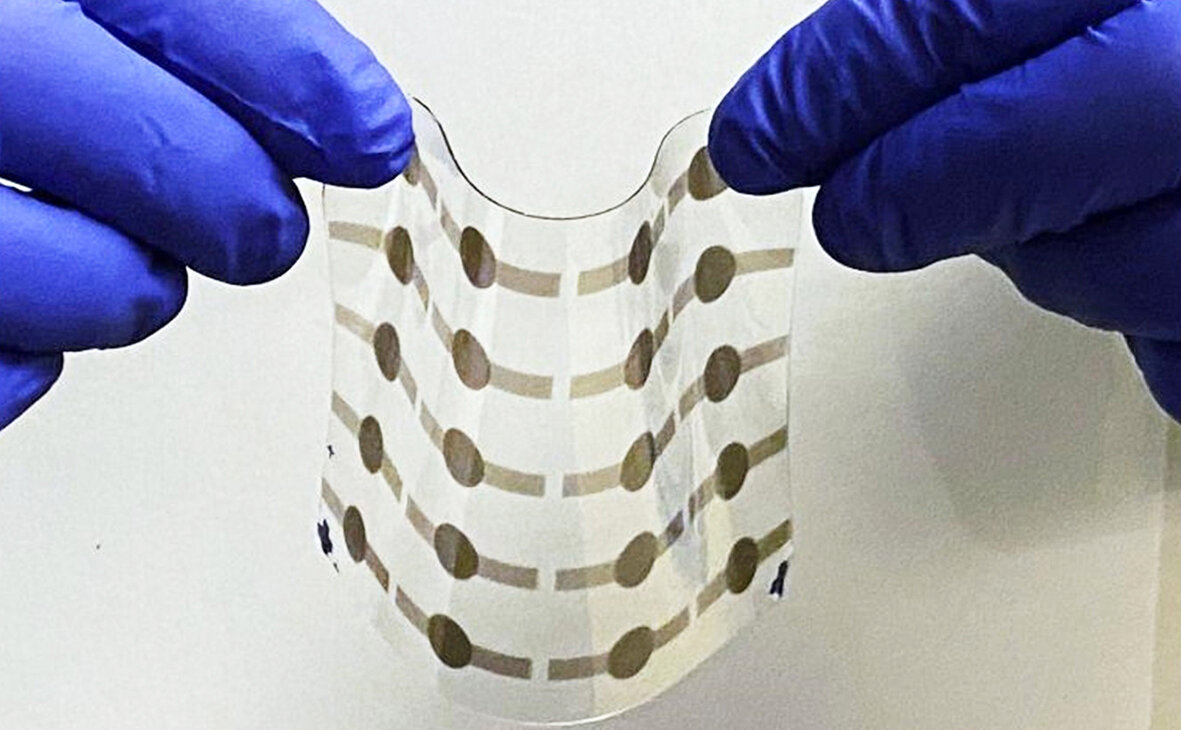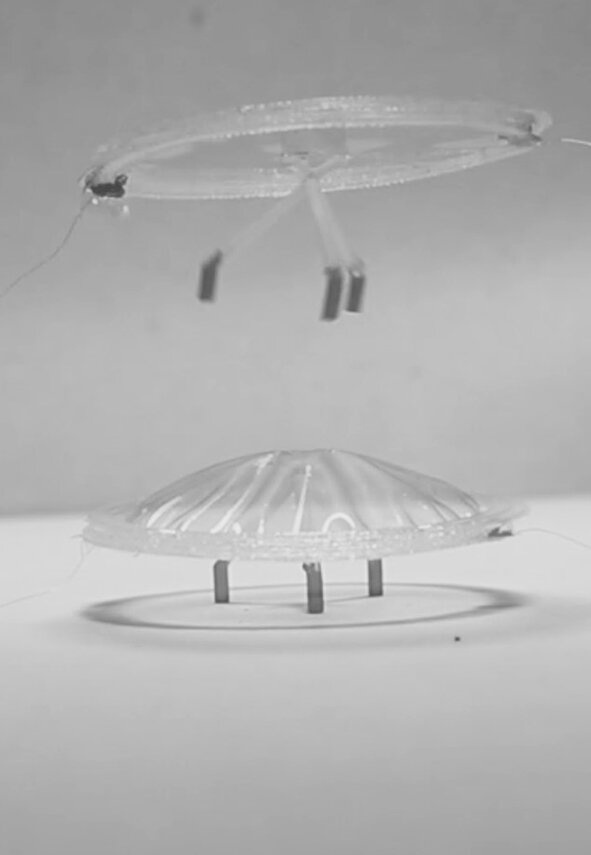博文
科学家们开发出一种用于柔性人造肌肉的耐用材料
 精选
精选
||
科学家们开发出一种用于柔性人造肌肉的耐用材料
诸平


Fig. 3 Video showing PHDE films and actuators undergoing tests. Credit: Soft Materials Research Lab/UCLA
据美国加州大学洛杉矶分校(University of California, Los Angeles简称UCLA)2022年7月7日提供的消息,UCLA的科学家们开发出一种柔性人造肌肉的耐用材料(UCLA Scientists develop durable material for flexible artificial muscles)。详见UCLA软材料研究实验室(Soft Materials Research Lab)提供的图1(Fig. 1)所示,即一种4×5英寸的薄膜,由10层可加工的高性能介电弹性体(high-performance dielectric elastomers简称PHDE)和20个致动器堆叠而成。
UCLA的科学家和非营利科学研究所斯坦福国际研究院(SRI International, Menlo Park, CA, USA)的同事们开发出了一种新的材料和制造工艺,用于制造比生物肌肉更强壮、更灵活的人造肌肉(artificial muscle )。
UCLA塞缪利工程学院(UCLA Samueli School of Engineering)材料科学与工程教授裴奇秉(Qibing Pei音译)表示:“创造一种能够进行工作、检测力和触觉的人造肌肉一直是科学与工程面临的重大挑战之一。”相关研究结果于2022年7月7日已经在《科学》(Science)杂志网站发表——Ye Shi, Erin Askounis, Roshan Plamthottam, Tom Libby, Zihang Peng, Kareem Youssef, Junhong Pu, Ron Pelrine, Qibing Pei. A processable, high-performance dielectric elastomer and multilayering process. Science, 7 Jul 2022, 377(6602): 228-232. DOI: 10.1126/science.abn0099. https://www.science.org/doi/10.1126/science.abn0099
参与此研究的除了来自美国UCLA和斯坦福国际研究院的研究人员之外,还有来自中国浙江大学(ZJU-UIUC Institute, Zhejiang University, Hangzhou, China)的研究人员。裴奇秉是此项研究论文的通讯作者。
为了将软材料(soft material)考虑用作人造肌肉(artificial muscle),它必须能够输出机械能(mechanical energy),并在高应变条件下保持活性,这意味着它在重复工作循环后不会轻易失去形状和强度。虽然许多材料被认为是制造人造肌肉的竞争者,但具有高弹性能密度的介电弹性体(dielectric elastomers简称DE)轻质材料因其最佳的柔韧性而备受关注。有视频显示高性能介电弹性体(PHDE)薄膜和正在进行测试的致动器(详见Fig.3)。
介电弹性体是电活性聚合物,是由大分子组成的天然或合成物质,在电场(electric field)刺激下,大分子的大小或形状会发生变化。它们可以用作致动器,使机器能够通过将电能(electric energy)转换为机械功来运行。
大多数介电弹性体由丙烯酸(acrylic)或硅树脂(silicone)制成,但这两种材料都有缺点。虽然传统的丙烯酸介电弹性体(acrylic DEs)可以实现高驱动应变,但它们需要预拉伸,缺乏灵活性。硅树脂类(Silicones)更容易制造,但它们不能承受高应变。
加州大学洛杉矶分校领导的研究团队利用商用化学品并采用紫外线(UV)光固化工艺,开发出一种改进的丙烯酸基材料,该材料更柔韧、可调,更易于扩展,同时又不会失去强度和耐久性。虽然丙烯酸能形成更多氢键(hydrogen bonds),从而使材料更易移动,但研究人员还调整了聚合物链之间的交联,使弹性体更柔软、更灵活。然后,将得到的薄、可加工、高性能介电弹性体膜(PHDE)夹在两个电极之间,以将电能转换为运动作为致动器。
每一层PHDE膜都像一根头发一样薄而轻,厚度约为35 μm,当多层膜堆叠在一起时,它们就变成了一个微型电动机,可以像肌肉组织一样工作,产生足够的能量来驱动小型机器人或传感器的运动。研究人员已经制作了一堆从4层到50层不等的PHDE薄膜。
裴奇秉说:“这种灵活、多功能和高效的致动器可以为新一代机器人的人造肌肉打开大门,也可以为传感器和可穿戴技术打开大门,使其能够更精确地模拟甚至改善仿人运动和能力。”
上述图2(Fig. 2)就是UCLA软材料研究实验室提供的一个直径约1.2 cm的跳跃机器人,装有PHDE致动器。
安装PHDE致动器的人造肌肉可以产生比生物肌肉更多的兆帕力,并且它们也显示出比自然肌肉3~10倍的灵活性。
多层软膜通常通过“湿法”工艺("wet" process)制造,该工艺涉及液体树脂的沉积和固化。但这一过程可能会导致不均匀的层,从而导致致动器性能不佳。因此,到目前为止,许多致动器仅在单层DE膜上获得成功。
UCLA的研究涉及一个“干”过程("dry" process),通过该过程,薄膜使用刀片分层,然后紫外线固化硬化,使层均匀。这增加了致动器的能量输出(energy output),使设备能够支持更复杂的运动。
简化的工艺,以及PHDE的灵活和耐用特性,允许制造能够弯曲跳跃的新型软致动器(new soft actuators),如蜘蛛腿,或卷绕和旋转。研究人员还证明了PHDE致动器能够投掷比PHDE薄膜重20倍的豌豆大小的球。当打开和关闭电压时,该致动器还可以像隔膜一样膨胀和收缩,这让人们得以一窥未来人造肌肉(artificial muscles)的用途。
这一进步可能会导致软机器人具有更好的机动性和耐力,以及新的可穿戴和触觉技术(haptic technologies)。该制造工艺(manufacturing process)也可应用于其他软薄膜材料,包括微流控技术(microfluidic technologies)、组织工程(tissue engineering)或微制造(microfabrication)。
上述介绍,仅供参考。欲了解更多信息,敬请注意浏览原文或者相关报道。
用于大规模驱动的单晶型纳米复合介电弹性体(A unimorph nanocomposite dielectric elastomer for large-scale actuation)
Designing better ways to stretch
Dielectric elastomers are a type of electroactive polymer that can transform electrical energy into mechanical work. They are often made from silicone or acrylic elastomers. Silicone materials are easier to process but have lower strains, whereas acrylics require prestrectching to achieve high strains. Shi et al. designed a dielectric elastomer based on acrylates in which the selection of monomers, the use of both a short and long cross-linker molecules, and the ability to control hydrogen bonding enabled fine tuning of the stress-strain responses and viscoelasticity. The authors further developed a method to dry stack the elastomeric sheets without a loss of properties that is more compatible with current large-scale fabrication processes. —MSL
Dielectric elastomers (DEs) can act as deformable capacitors that generate mechanical work in response to an electric field. DEs are often based on commercial acrylic and silicone elastomers. Acrylics require prestretching to achieve high actuation strains and lack processing flexibility. Silicones allow for processability and rapid response but produce much lower strains. In this work, a processable, high-performance dielectric elastomer (PHDE) with a bimodal network structure is synthesized, and its electromechanical properties are tailored by adjusting cross-linkers and hydrogen bonding within the elastomer network. The PHDE exhibits a maximum areal strain of 190% and maintains strains higher than 110% at 2 hertz without prestretching. A dry stacking process with high efficiency, scalability, and yield enables multilayer actuators that maintain the high actuation performance of single-layer films.
https://m.sciencenet.cn/blog-212210-1346678.html
上一篇:物理学家首次看到电子漩涡
下一篇:在扭曲的三层石墨烯中观察到异常的超导性
